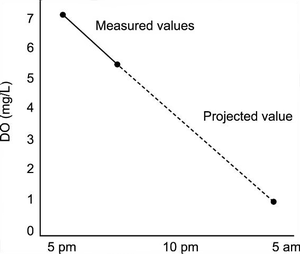Dissolved oxygen
Dissolved Oxygen (O2) (mg/L). The amount of oxygen currently dissolved in a body of water.
This gas is constantly entering water from two main sources: the atmosphere and from photosynthesis.
Dissolved oxygen concentrations can be determined by conducting a series of complex chemical reactions via a 'test kit' or by measuring electronically with an oxygen meter (a.k.a. a DO meter).
Note: Some species of fish require a minimum high level of DO to survive. These are typically long, thin shark-type species. They are designed to swim fast and therefore breath fast.
- A beaker of sterile freshwater left to stand at 25C will hold a maximum of 8.2 mg/L of Oxygen (this is said to be 100% saturated).
| Temp °C | freshwater | saltwater |
|---|---|---|
| 0 | 14.6 | 11.7 |
| 5 | 12.8 | 10.4 |
| 10 | 11.3 | 9.3 |
| 15 | 10.1 | 8.5 |
| 20 | 9.1 | 7.8 |
| 25 | 8.2 | 7.1 |
| 30 | 7.5 | 6.5 |
- A level of 7+mg/L is considered high.
- A level of 5–6 mg/L is considered to be normal.
- A level of 4 mg/L is considered low and getting potentially deadly.
Water Conditioners and their effect on dissolved oxygen[edit]
All water conditioners on the market when first added to aquarium water will slightly reduce the oxygen content of the water (especially if there is no ammonia or nitrate/nitrite to neutralise). However this is typically in the small order of 0.5ppm of Oxygen and only for approximately the first 15 minutes of use. This should never be an issue in a normal healthy aquarium. But in a heavily overpopulated poorly maintained tank an aerator may be briefly required. But in these cases you need to seriously think about reducing the population in your tank or getting a bigger tank.[1][2]
References[edit]
Links[edit]
- A Beginner's Guide to Water Management - Oxygen and Temperature
- Levels of dissolved Oxygen in the aquarium by the OATA
